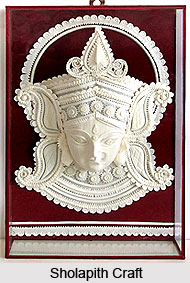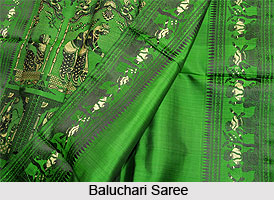Handicrafts of Murshidabad district are hugely acclaimed not only in the country but also across the globe. The history of these crafts is enrooted in the ancient past when these craftworks flourished under royal patronage. Since then, a number of artisans emerged in different parts of the district. Numerous artefacts are produced with a variety of materials such as ivory, wood, sholapith, bell-metal and silk. Meticulous and elaborate designs are furnished on the handicrafts, some of which takes a long time to complete.
 Ivory and Wood Handicraft
Ivory and Wood Handicraft
Murshidabad district is famous for its ivory and wood handicrafts having its origin in the times when Nawabs of Bengal had their court in the district. The industry flourished with the luxurious support of wealthy noblemen, the craftwork faced a crisis with the decline of the power of Nawabs. The ivory crafts were also admired during the British rule and were also exported to different parts of the country. Railway communication in that period helped a great deal to flourish this art. The artisans practicing Ivory and Wood handicraft once used to receive orders from the Government for supplying their artefacts in the exhibitions of England and other European countries. The main centres of this industry in the districts were located at Mathra, Ranshagorgram and Daulatbazar.
Sholapith Handicraft
Another renowned craftwork of Murshidabad district is Sholapith handicrafts. Sholapith is white coloured spongy wood taken from a plant known as Sola. Sola mostly grows wildly in waterlogged marshy areas. Sholapith is in fact the core or cortex of the plant having one and a half inch of diameter. Although it resembles a thermocol, it is superior to it in terms of texture, malleability, sponginess and lustre. The testaments of this handicraft can be seen on the images of Gods and Goddesses during festivals and as beautiful backdrops in Durga Puja celebrations. Sholapith is meticulously carved with beautiful designs. The common motifs of this craft include floral designs, garlands, decorative head-wears of deities, elephant-howdahs, palanquins and peacock-boats.
 Bell Metal Handicrafts
Bell Metal Handicrafts
Handicrafts of Bell metal and brass utensils are found mostly in Khagra, Kandi, Jangipur, Berhampore and Baranagar. They cater both the local as well as international markets. Dhulian is known for betel nut cutters and locks whereas iron chests are manufactured at Jangipur. However, there is a persisting problem in acquiring the raw materials by the artisans owing to the complicated formalities involved in submitting of applications.
Silk Industry
Baluchar town in the district is famous for Baluchari sarees. The saris have a base of silk with silk brocaded designs of varied hues. However strong contrast in terms of colour is avoided in these saris. Artisans from Muslim community are known for traditionally producing these saris with depiction of figured patterns, horse with a rider, court scenes and women smoking hookah. Floral borders surrounding the cone motif or the Kalka design are also common. Silk saris of Bengal are famed not only in the country but also in the international market.
Handicrafts of Murshidabad district have well captured the international markets too. Since ancient times, there is a huge demand for them worldwide and a major portion of these artefacts are exported. These handicrafts have greatly enriched the cultural heritage of the country and have also contributed in the bloom of handicraft industry of India.






